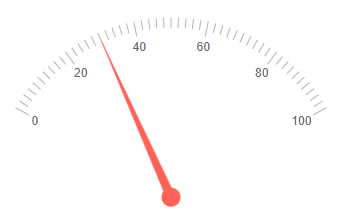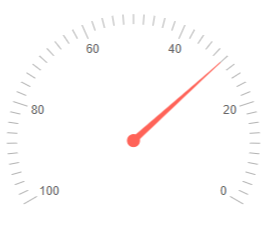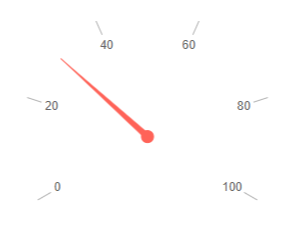Radial Gauge Scale
The Scale of the Radial Gauge renders the values, pointers and labels. You can customize it by adding an instance of the <RadialGaugeScale> to the <RadialGaugeScales> collection, child tag of the <TelerikRadialGauge>. The <RadialGaugeScale> exposes the following parameters:
Min and Max
The
Max(double) parameter controls the maximum value that the component can reach.The
Min(double) parameter controls the minimum value of the component.
Change the minimum and the maximum values for the scale. The result from the code snippet below.

@* Use the Min and Max parameters to change the minimum and the maximum values for the scale *@
<TelerikRadialGauge>
<RadialGaugeScales>
<RadialGaugeScale Min="10" Max="100"></RadialGaugeScale>
</RadialGaugeScales>
<RadialGaugePointers>
<RadialGaugePointer Value="10">
</RadialGaugePointer>
<RadialGaugePointer Value="40">
</RadialGaugePointer>
<RadialGaugePointer Value="70">
</RadialGaugePointer>
</RadialGaugePointers>
</TelerikRadialGauge>
MinorUnit and MajorUnit
The
MajorUnit(double) parameter controls the interval between the major unit divisions of the component. The labels will be rendered next to theMajorUnitticks.The
MinorUnit(double) parameter controls the interval between the minor unit divisions of the component.
Change the rendering frequency of the minor and major unit divisions. The result from the code snippet below.

@* Update the rendering of the major and minor units *@
<TelerikRadialGauge>
<RadialGaugeScales>
<RadialGaugeScale MajorUnit="10" MinorUnit="5"></RadialGaugeScale>
</RadialGaugeScales>
<RadialGaugePointers>
<RadialGaugePointer Value="30">
</RadialGaugePointer>
</RadialGaugePointers>
</TelerikRadialGauge>
StartAngle and EndAngle
The gauge is rendered clockwise (0 degrees are the 180 degrees in the polar coordinate system).
StartAngledefines the start angle of the gauge, its default value is 0.EndAngle- defines the end angle of the gauge, its default value is 180.
Change the StartAngle and EndAngle of the radial gauge. The result from the code snippet below

@* Change the StartAngle and EndAngle of the radial gauge *@
<TelerikRadialGauge>
<RadialGaugeScales>
<RadialGaugeScale StartAngle="30" EndAngle="150">
</RadialGaugeScale>
</RadialGaugeScales>
<RadialGaugePointers>
<RadialGaugePointer Value="30">
</RadialGaugePointer>
</RadialGaugePointers>
</TelerikRadialGauge>
Reverse
If you set the Reverse (bool) parameter to true the gauge will be rendered in a reversed view - the min value will be on the right side and the max value will be on the left.
Reverse the component. The result from the code snippet below.

@* Set the Reverse parameter to true *@
<TelerikRadialGauge>
<RadialGaugeScales>
<RadialGaugeScale Reverse="true"></RadialGaugeScale>
</RadialGaugeScales>
<RadialGaugePointers>
<RadialGaugePointer Value="30">
</RadialGaugePointer>
</RadialGaugePointers>
</TelerikRadialGauge>
Additional Customization
To further customize the elements of the Radial Gauge you can use nested tags. When configuring nested properties and child elements in your Radial Gauge, the inner tags will contain their parent tag name and add specifics to its end. In general the structure of such nested tags will be <RadialGauge*Category**Specifics*> where the Category can be one of the following:
- Scale
- GaugeArea
- Pointers
Example: Remove the MinorUnit ticks
You can remove the MinorUnit ticks from the rendering of the scale by using the <RadialGaugeScaleMinorTicks> nested tag and its Visible parameter.
Remove the MinorUnit ticks. The result from the code snippet below.

@* Remove the MinorUnit ticks. *@
<TelerikRadialGauge>
<RadialGaugeScales>
<RadialGaugeScale>
<RadialGaugeScaleMinorTicks Visible="false"></RadialGaugeScaleMinorTicks>
</RadialGaugeScale>
</RadialGaugeScales>
<RadialGaugePointers>
<RadialGaugePointer Value="30">
</RadialGaugePointer>
</RadialGaugePointers>
</TelerikRadialGauge>